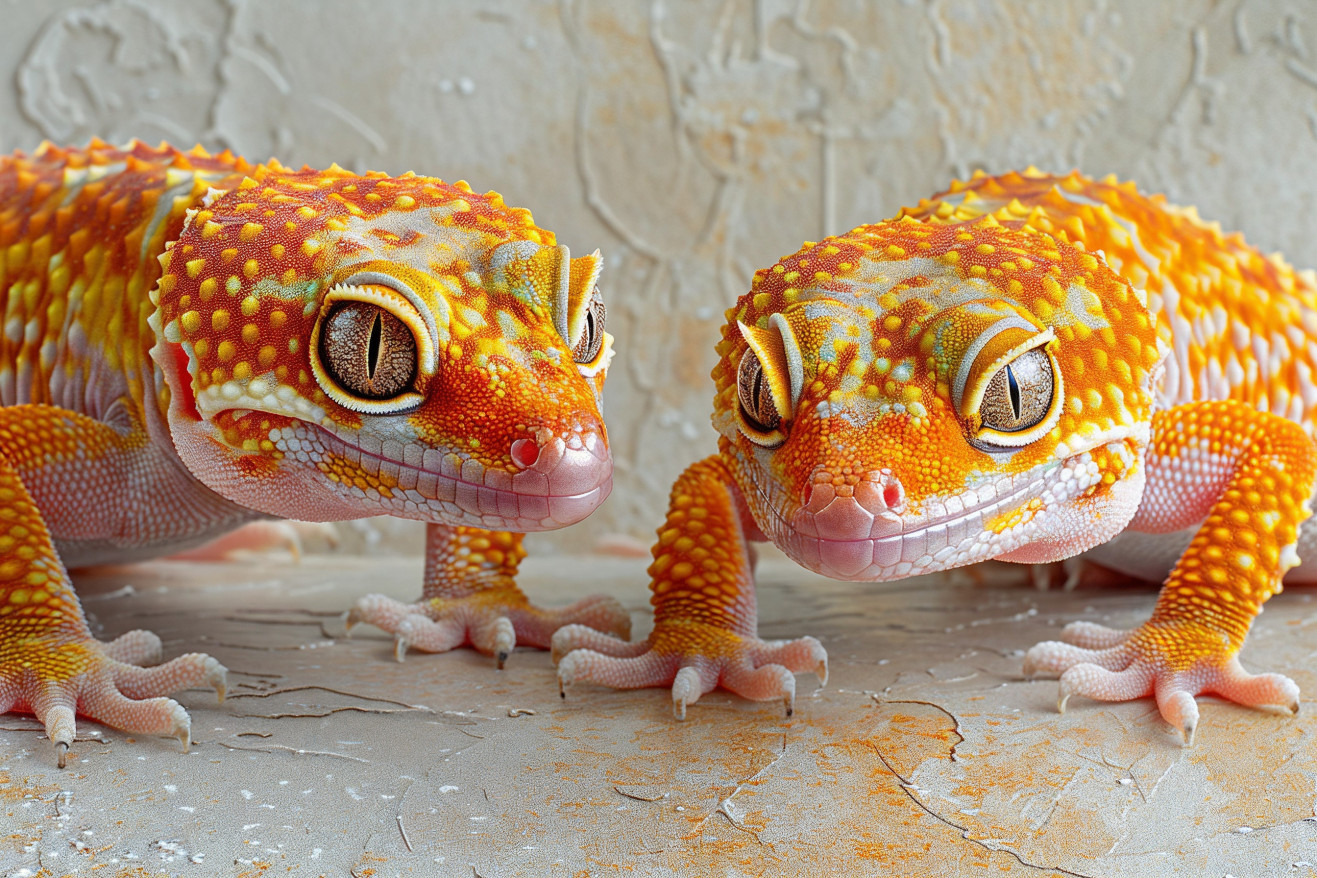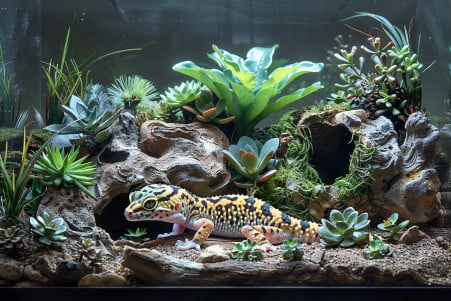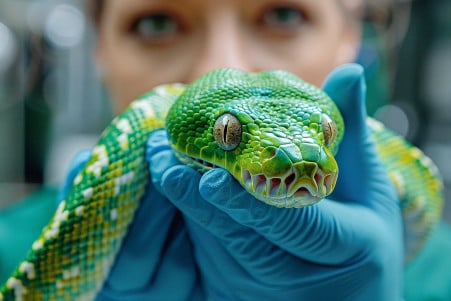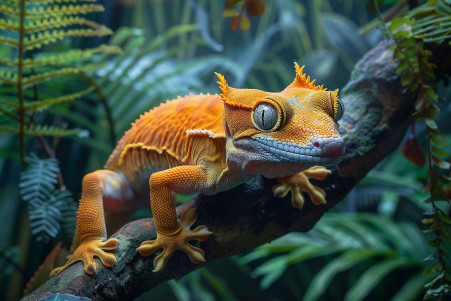How to Determine the Sex of Your Leopard Gecko: A Step-by-Step Guide
14 June 2024 • Updated 13 June 2024

Sexing a leopard gecko can be difficult, but there are a number of ways to tell based on their size, shape, pores, and bulges. Males are generally larger with a wider body, femoral pores on the underside near the back legs, hemipenal bulges that stick out, and a base of the tail that is thicker than the female's slender tail.
Whether you want to know how to sex your leopard gecko or you're looking to pair up a male and female for breeding, it's important to know how to identify these physical characteristics. This article will take a close look at visual identification methods, provide in-depth anatomical descriptions, and reference reptile vets for their expert opinions on how to accurately sex your leopard gecko pets.
How can you tell if a leopard gecko is male or female?
Physical Characteristics to Determine Sex
If you're trying to figure out if your leopard gecko is male or female, you'll need to take a close look at their physical characteristics. According to The Spruce Pets, one of the most reliable ways to tell is by looking at the pre-anal pores, which are found in a V-shaped row in front of the vent in males. While females also have a row of pre-anal pores, they are much less noticeable.
You'll also want to look for hemipenal bulges - two oval-shaped lumps located behind the vent that indicate the presence of male genitalia. These bulges house the hemipenes and are only found in male leopard geckos.
Another way to tell the difference is by looking at the femoral pores on the underside of the back legs. These pores are visible as a row of white dots and are much larger and more pronounced in male geckos that are maturing than in females, according to Petco.
In addition to these specific anatomical characteristics, there are some general differences in body shape and size that can help you determine your leopard gecko's sex. For example, adult male leopard geckos are typically larger and more robust, and they have thicker tails at the base to accommodate the hemipenal sacs. Females are generally more slender and have a more streamlined body shape.
It's important to keep in mind that these differences in physical characteristics become more noticeable as leopard geckos mature, which happens around 10 months of age. In younger geckos, these characteristics may be less pronounced, which can make it harder to determine their sex.
Sexing Juvenile and Young Leopard Geckos
According to How to Sex Leopard Geckos: 3 Things to Look For, the most reliable way to sex leopard geckos is when they are at least 6 months old and have grown to a certain size. This means that in younger geckos, the differences in the sexes may be less obvious or even harder to see.
As the gecko grows, look for the development of pores, bulges, and body shape. Also, the temperature the egg was incubated at can be a good indicator of the gecko's sex, with higher temperatures leading to more males.
If you're trying to sex leopard geckos that are very young, it's best to get help from experienced breeders or reptile vets. This will help ensure that you don't make mistakes when trying to sex immature animals.
Housing and Cohabitation
Because of their territorial behavior, it is not recommended to house multiple male leopard geckos together. Per Reptile Forums, housing male leopard geckos together "almost always results in them fighting or stressing each other to the point that one is injured, killed, or both are injured or killed."
While keeping a single male with multiple females is a more common breeding setup, it is one that requires careful observation as the geckos grow and mature. Per Pets on Mom.com "a group of females and a single male can also live together with the proper amount of space and care." Females may require special care when it comes to egg-laying and should be given a place to lay their eggs.
If housing females together, make sure to provide a larger enclosure with multiple hides and keep a close eye on their food consumption and waste. Go Herping explains that "even if you are monitoring them, they can suddenly decide they do not like the other female." Size differences between cohabiting geckos can lead to bullying, so it's best to house similarly sized individuals together.
How to Take Care of Leopard Gecko Eggs and Babies
If you are breeding leopard geckos, you will need to know how to take care of any eggs that your female lays and successfully incubate them. According to Professional Reptiles, this involves carefully removing the eggs and placing them in an incubator that is set to the right temperature, humidity, and substrate. Gecko Time explains that the temperature at which the eggs are incubated will also determine the gender of the babies, with cooler temperatures resulting in more females.
Babies will need to be housed in a safe, well-ventilated environment and fed small prey that is appropriately sized for their age and size. Terrarium Quest suggests that babies can be housed in plastic shoe box setups until they are about 7 inches long. Babies should be watched for any signs of illness or developmental issues, and veterinary care should be sought if any concerns arise.
How to Tell If Your Leopard Gecko Is Stressed and What to Do About It
Stressed leopard geckos may display a number of behaviors that can be cause for concern, such as hiding, tail waving, vocalizations, and an overall inability to calm down. According to Leopard Gecko Care, these behaviors are signs that the gecko feels threatened or stressed.
Some of the most common causes of stress in leopard geckos include environmental factors like incorrect temperatures and lighting, handling, shedding, and the presence of other animals in their enclosure. Reptile Guide also explains that if stress is left unaddressed for too long, it can result in a loss of appetite, weight loss, and other health issues that need to be treated by a veterinarian.
To help prevent stress, make sure that your leopard gecko's habitat is set up with the proper hiding spots, temperatures, and humidity levels. In addition, as Terrarium Quest explains, make sure to listen to your gecko and avoid handling it if it's showing signs of stress. By addressing the causes of stress, you can help ensure that your leopard gecko stays healthy and happy in the long run.
Common Health Problems and Veterinary Care
Leopard geckos are at risk for a number of health issues if they are not properly cared for, including impaction, parasites, and respiratory infections. My Family Vets reports that the most common health problem in geckos is impaction, which can be fatal if not treated. Internal parasites can also lead to regurgitation, weight loss, and lethargy.
Other problems that you may encounter include shedding issues, metabolic bone disease, tail loss, and mouth rot. The Critter Depot explains that leopard geckos are especially susceptible to hypovitaminosis A, nutritional secondary hyperparathyroidism, and cryptosporidiosis. Arizona Exotics adds that eye problems, skin infections, and respiratory infections are also common.
Be on the lookout for signs of sickness like lethargy, loss of appetite, labored breathing, and anything else that seems out of the ordinary. Reptile Files suggests that you keep a log of your gecko's weight, feeding, behavior, and shedding. If you notice anything concerning, make sure to get in touch with a reptile veterinarian as soon as possible. Many of the health problems that occur in captive leopard geckos can be avoided with the right husbandry, diet, and habitat.
Conclusion: How to Make Sure Your Leopard Gecko Gets the Right Care
Knowing how to sex a leopard gecko is important for their health, breeding, and general care. The most reliable way to sex a leopard gecko is by visually examining physical traits such as pores, bulges, and body shape. According to The Spruce Pets, male leopard geckos have a V-shaped row of pre-anal pores, hemipenal bulges, and enlarged femoral pores, while females do not have these features.
Especially when sexing juveniles or young geckos, where the differences may be less obvious, it's important to get help from experienced reptile keepers or veterinarians. Reptile Files says leopard geckos can be sexed with confidence once they reach about 5-6 inches in length.
To make sure your leopard gecko stays healthy and happy, it's important to provide the right housing, nutrition, and environmental conditions. Regular monitoring and quick veterinary intervention can help you catch and treat any issues that may arise. By knowing the differences between male and female leopard geckos, you can make sure your pet gets the care they need to thrive.


